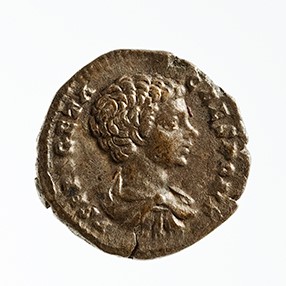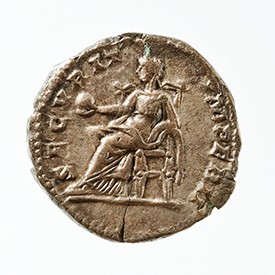Title: Denarius of Geta, reign of Septimius Severus - 1966.54
Acquisition number: 1966.54
Author or editor: Beryl Rawson
Culture or period: Roman Imperial
Date: AD 198-209
Material: Metal - Silver
Object type: Coins - Roman
Dimensions: 18mm (w)
Origin region or location: Italy
Origin city: Rome
Display case or on loan: 7
Keywords: Coin, denarius, Roman, Imperial, Geta, Septimius Severus, Securitas
Sear, D.R., Roman Coins and their Values 5 vols (London, Spink, 2000-2014) 7200; Mattingly, H., E.A. Sydenham, C.H. Sutherland, R.A. Carson, The Roman Imperial Coinage 13 vols (London, Spink, 1923-1994) IV (Mattingly and Sydenham) 316 no. 20 (a) and pl. 14 .4; Seaby, H.A., Roman Silver Coins (London, B.A. Seaby, 1967) III 183; Mattingly, H.,Coins of the Roman Empire in the British Museum, 6 vols (London, 1965) S240-3.
1966.54
Denarius of Geta, reign of Septimius Severus
3.019 g. AD 198-209
Obv.: Bust of Geta r., bare-headed, draped. P(ublius) SEPṬ(imius) GETA CAES(ar) PONT(ifex).
Rev.: Securitas seated l. on a throne; draped, with a globe in right hand. SECVRIT(as) IMPERII.
Geta, the younger son of Septimius Severus, was appointed Caesar in AD 198. This probably coincided with Septimius’ victory over the Parthians. This coin must date between AD 198 and 209 when he was given the title ‘Augustus’ (also held by his father and his elder brother Caracalla). Septimius seems to have intended that Geta and Caracalla should reign jointly after his death, but Caracalla had Geta assassinated in AD 212.
The legend ‘Securitas Imperii’ fits the image of Septimius Severus who, as a military man, was chiefly interested in the security of the frontiers. It was also only in AD 197 that Septimius disposed of rival claimants to imperial power. Further, the legend is probably connected with Septimius’ dynastic arrangements, which assured the security of the reign and the succession.
Sear, D.R., Roman Coins and their Values 5 vols (London, Spink, 2000-2014) 7200; Mattingly, H., E.A. Sydenham, C.H. Sutherland, R.A. Carson, The Roman Imperial Coinage 13 vols (London, Spink, 1923-1994) IV (Mattingly and Sydenham) 316 no. 20 (a) and pl. 14 .4; Seaby, H.A., Roman Silver Coins (London, B.A. Seaby, 1967) III 183; Mattingly, H.,Coins of the Roman Empire in the British Museum, 6 vols (London, 1965) S240-3.

